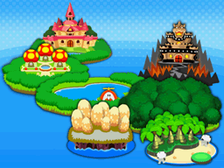Mario and Luigi: Dream Team Bros. – Table Design Meets Overworld Design
April 28th, 2018
Mario and Luigi: Dream Team Bros.‘s hub-based overworld design and Bowser’s Inside Story‘s organic overworld design function much like the circular dining tables of Chinese culture and the rectangular dining tables of Western culture.
Round tables symbolise collectivist ideology where all participants are equal. Each member sits equal distance apart and is therefore able to see everyone else at the table and easily participate in group discussion. With Dream Team Bros.‘s hub-based map design, each area is equal distance apart and requires roughly the same amount of play time to complete. Players can easily navigate between areas through the centre point (engage in the main conversation) or move between adjacent areas (converse with the person next to them). Since everything is orientated around a centre, the design minimises the amount of backtracking (private conversation).
Rectangular tables contain a head and a foot for those individuals of distinction. Similarly, Bowser’s Inside Story‘s worlds of varying shapes and sizes fit within the confines of a rectangular box. The access to different areas of the map is therefore uneven much in the same way that someone on one side of a rectangular table might struggle to speak to someone on the other side. The design favours those who sit in the middle of the table and are able to navigate between conversations on either sides. Meanwhile the corners remain isolated. Usually, if someone wishes to talk to a person outside of clear speaking distance, they’ll move or switch chairs at some point later in the meal. Similarly, as the player progresses through BIS, they’ll discover the underground train network known as Project K which allow them to fast travel across the map.
What I like about games like BIS is how this unevenness in the overworld design characterises the play experience. Dimble Woods and Blubble Lake are frequent junctions, sharing the centre area of the map. You pass through these areas multiple times and they have multiple entry and exit points. Toad Town joins Blubble Lake and Peach’s Castle, while Plack Beach archs around between Dimble Woods and Cavi Cape. Both areas act as a sub-juncture. Bumpsy Plains is a small join between areas. The remaining locales dwell on the outskirts and naturally take longer to reach. To further complicate the relationship between these areas, the Project K railroad links the fringes in a circle. The uneven jigsaw of worlds gives each area a personality pertinent its relative positioning and functional role within the geography. The dynamics of space and mobility play out much like the social dynamics governing where we choose to sit and who we choose to sit next to at a rectangular table.
In terms of its impact on the experience, the design of a table doesn’t differ much from the design of an overworld in a video game. These analogies work because the dynamics of space and mobility are universal.





 Game Design Companion: A Critical Analysis of Wario Land 4 - $7.99
Game Design Companion: A Critical Analysis of Wario Land 4 - $7.99 Level Design: Processes and Experiences
Level Design: Processes and Experiences Speed Boost: The Hidden Secrets Behind Arcade Racing Design - $5.99
Speed Boost: The Hidden Secrets Behind Arcade Racing Design - $5.99 Adventures in Games Analysis: Volume I - $5.99
Adventures in Games Analysis: Volume I - $5.99







